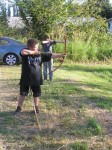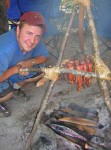The Opposite of Panic

Experts say “don’t panic” in case of emergency, but we are biologically wired with a “freeze, fight or flee” response, so the only people who don’t automatically panic are trained emergency responders. So what are the rest of us to do?
When we panic, adrenaline floods our system, and our “lower thinking” brain stem is stimulated. The “higher thinking” frontal cortex is shut off, a situation exacerbated by what I like to call “hypo-ventilation,” or breathing in a rapid but shallow way: air is caught in our throats rather than reaching our lungs, blood stream, and frontal cortex.
It might be that you do need to “fight or flee” if being attacked, but in most wilderness emergencies situations, it’s just a “freeze” situation. And yes, that’s a play on words. First, as the survival specialist Peter Kummerfeldt recommends, just freeze! In other words, stop for 20 minutes (look at your time piece) to calm down, and often, you will know where you are and what to do.
You need your body to exit its panic mode, and the way to do this is to breathe. But if you have ever panicked, you know that breathing is easier said than done. My trick, learned from having to deal with asthma attacks in my younger years, is to stand, leaning over a bit with my hands on my knees, and then blow all the air out of my lungs by pushing my stomach inwards as far as I can. You can’t help but to suck air back in once you’ve done that.
Remember this: If people would just stop for 20 minutes the first time they had an feeling they might be lost, they would probably realize they are just a few feet from the correct path. Could you imagine how quickly Search & Rescue would find someone who had stopped the first time they felt a little lost? So just stop. Breathe. Drink water. Eat a bite. You’ll probably know what to do in 20 minutes. If not, just stay put.
The Critical Order of Emergency Wilderness Survival

Let’s consider a scenario where you are lost in the woods, it’s getting dark, and a cold storm is blowing in. What do you do now that you are staying calm with your breathing? The answer is to follow the order of survival, which follows what the late survival specialist Dr. Ron Hood called the Rule of Three. However, there we actually have four basic needs, and with mental strength (just breathe and think of something or someone you want to live for) we can break that rule, so call it the Law of Fours:
What can’t you live without for more than about 4 minutes? Air. What can’t you live without for more than about 4 hours in the severest of weather? Warmth. What can’t you live without for more than about 4 days before getting critically dehydrated? Water. What do you need within about 4 weeks? Good Food. This is the Law of Fours.
Of course, you can even live beyond the Law of Fours. Young people have come back to life after an hour stuck in water beneath ice, if the mammalian diving reflex kicked-in to trap air in their lungs and slow their metabolism, then they were warmed up very slowly under medical attention. And if you think about it, you can survive without warmth, water and food forever if you just keep breathing.
Navigate Out or Make Shelter?

Why have children survived in cold emergencies better than some adults? Children often behave more instinctively. In search and rescue, we are often more cautiously optimistic about a situation if a genuinely lost person is a child, because more often than adults, the child will instinctively seek shelter and stay there, at least during the night.
King County Search & Rescue once tracked a child who was lost for 3 days in the foothills near Seattle, and the media reported a doctor’s statement claiming no one could survive the cold spell that was taking place. The child was found alive and relatively well a couple days later. Our tracking unit saw that the child had curled up under natural shelter at night.
That situation also highlights the fact that it is shelter, not fire, which best addresses your need for warmth. How do we shelter ourselves during a wilderness emergency? I used to believe survival experts when they claimed that a “debris hut” was a great survival shelter. After many, many years of building debris huts with friends, students and campers, I finally realized that the debris hut is useless during a real emergency.
Bivouac With Or Without A Tarp

In a true emergency, you are only going to have a few minutes between the time you realize you need to make shelter, and nightfall. A debris hut is a waste of time, unless 1) you live where deciduous trees or tall grasses leave overwhelmingly abundant debris, 2) you are mentally inclined as a structural engineer with access to the right size sticks, and 3) you are not injured in any way, have good gloves, and … you get the picture: if you meet these qualifications, you aren’t in an emergency situation.
If you are stuck somewhere in a true wilderness survival situation, all you can really do the first day, beyond breathing to calm yourself, is to bivouac. 1) get out of the wind to protect from cold, or out of the sun to protect from heat. 2) Get away from water where it is dangerous and cold, especially at night, staying uphill a bit away from noisy creeks where you and rescuers can’t hear each other. 3) If you have time and knowledge, look for debris to enhance your shelter, primarily to put underneath you to insulate from the cold ground, especially if staying overnight. In hot, sunny areas, find or create shade during the day, even if just one part of your body fits underneath.
If you have an able body, then build what I call an Eagle’s Nest as the best emergency shelter. The eagle’s nest was invented by a group of kids I was supervising during a fundraiser for the Rocky Mountain Elk Foundation in Chehalis, Washington They taught me, again, that we just need to look at what kids do for survival.
This particular group wanted to build a shelter “for fun” and I said “go ahead.” They proceeded to pile a bunch of debris together, place sticks around it like they were building a debris fort, and they even managed to erect a roof within 20 minutes. I rolled my eyes, thinking that the shelter would just fall apart.
I was wrong. A kid climbed in and was too warm in there even though it was about 40°F and raining. Those kids had just invented the Eagle’s Nest Survival Shelter. Start with the worst debris which will stay on the bottom of your nest, and save the best/driest material for right underneath you. If you have more than 20 minutes and an able body, then build walls, too. An hour? You can make a roof if sticks and bark are handy. If you have a bivouac device, like a garbage bag, then cut a hole in its side near the top, and wear it like a poncho; or if you know how to rig a tarp from plastic, then put that over your eagle’s nest.
My next article in this series will include construction advice for the Eagle’s Nest Shelter, which is the best way to enhance a bivouacking situation. Further, if you thought ahead and brought your 10 Essentials, you should have a plastic bag with you, and my upcoming Eagle’s Nest article will discuss the best ways to use a plastic bag for shelter, as well as provide recommendations for even better options to bring such as the Adventure Medical emergency and thermal bivi bags.
By the way, don’t bring “emergency blankets” unless you know how/what to use them for, and have practiced using them! Hint: They should really be called “delicate reflective tarp sheets” if used for wilderness applications. Just remember: get out of the wind, get away from water, and gather as much debris as you can to raise yourself off cold ground. That’s what will make plastic emergency bags work if you have to bivouac.
Chris Chisholm is founder and co-owner of Wolf Camp & School of Natural Science. For in-depth learning, check out our Classes & Workshops.











